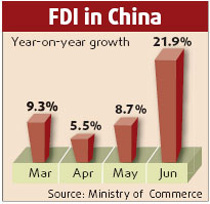China's gross domestic product (GDP) reached 24.6619 trillion yuan (3.43 trillion US dollars) in 2007, up 11.4 percent year-on-year, the National Bureau of Statistics (NBS) said on Thursday.
The growth rate was 0.3 percentage points higher than the 2006 level, which was a revised 11.1 percent.
NBS head Xie Fuzhan told reporters that 2007 was the fifth year in a row during which GDP had expanded by more than 10 percent. Analysts said the 2007 figure was also the highest of the past 13 years.
Breaking economic growth down by quarter, GDP expanded 11.1 percent in the first quarter, 11.9 percent in the second, 11.5 percent in the third and 11.2 percent in the fourth.
Xie said that the United States and China had been powerful engines for the current cycle of global growth. However, the mounting possibility of the US economy moving into a recession was bound to have a negative effect on the world economy.
However, Xie said that he was confident of China's economic prospects, with "steady" growth likely this year.
Xie said: "We will keep a close watch on developments in the US economy on one hand. On the other hand, we'll be striving to address institutional and structural problems in the Chinese economy."
He said there was still a risk that China's economy could shift from rapid growth to overheating this year, with growing inflationary pressure. To avert this, the central government had adopted a tight monetary policy in tandem with a prudent fiscal policy for 2008.
The NBS also reported that in 2007, primary industry output was 2.89 trillion yuan, up 3.7 percent, while that of the secondary sector was 12.14 trillion yuan, up 13.4 percent, and the tertiary sector, 9.63 trillion yuan, up 11.4 percent.
The growth rate for the primary sector was 1.3 percentage points lower than in 2006, while the rates for the secondary and tertiary sectors were 0.4 percentage point and 0.6 percentage point higher, respectively.
According to Xie, 2007 was the fourth straight year of growth in grain production. The harvest was 501.5 million tons, up 3.5 million tons, or 0.7 percent, over the 2006 level.
Major industrial enterprises (that is, those with annual sales of more than 5 million yuan) saw production rise 18.5 percent year-on-year, or 1.9 percentage points more than in 2006. Their aggregate profits were 22.95 trillion yuan, up 36.7 percent, or six points more than in 2006.
Last year also witnessed accelerated growth in fixed-asset investment nationwide, with the real estate sector leading the way.
Spending on fixed assets totaled 13.72 trillion yuan, up 24.8 percent, or 0.9 percentage points more than in 2006.
The total included 11.74 trillion yuan in urban areas, up 25.8 percent (1.5 points more than in 2006), and 1.98 trillion yuan in rural areas, up 19.2 percent.
Property development spending was 2.53 trillion yuan nationwide, up 30.2 percent, or 8.4 percentage points higher.
Wang Xiaoguang, a senior economist with the research institute of economic operation and development under the National Development and Reform Commission, said he believed that the impressive growth in real estate spending reflected, at least in part, rising government spending for low-income housing.
In terms of consumer spending, 2007 retail sales went up 16.8 percent to 8.92 trillion yuan, up 3.1 percentage points. The total included 6.04 trillion yuan in urban areas, up 17.2 percent, and 2.88 trillion yuan in rural areas, up 15.8 percent. Those growth rates were higher than in 2006 by 2.9 points and 3.2 points, respectively.
The consumer price index (CPI) was up 4.8 percent, exceeding the government's target of 3 percent. The CPI was also 3.3 percentage points higher than in 2006.
Food prices, which account for a third of the index, drove the CPI higher: they were up 12.3 percent during 2007.
Xie said that the pressure of excess liquidity also contributed to the CPI rise.
The outstanding amount of narrow money, or M1 (cash plus corporate current deposits), stood at 15.3 trillion yuan, up 21 percent, while that of broad money, or M2 (M1 plus residential savings deposits), amounted to 40.3 trillion yuan, up 16.7 percent. Cash in circulation (M0) increased 12.1 percent to 3.03 trillion yuan.
M1 growth was up 3.5 percentage points from 2006. M2 growth slipped 0.2 percentage point. M0 growth dipped 0.6 percentage point.
(Xinhua News Agency January 24, 2008)


